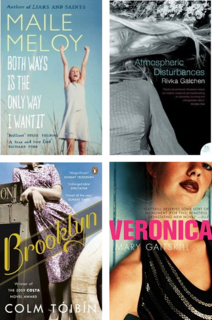Uniformity
Fatema Ahmed
In an interview with Back Cover earlier this year, Richard Hollis, the graphic designer, writer, teacher and now publisher, said that when he was starting out fifty years ago,
Designers were more like doctors then. A client would consult them, and say: ‘My problem is, I’ve got to tell these people about this and that.’
Looking at books in British bookshops for the first time in a while, I began to wonder what symptoms the patients, four different publishers in this case, complained of to get these cures:
The writers have nothing in common when it comes to style or sensibility but these covers say otherwise. The partly obscured figure of a woman against a plain, usually blue, background has been a staple of British publishing for some years now. Depending on where you are and how you feel about Amazon, theAmericanequivalents are either cheering (there’s something else out there) or depressing – why, given the choice, would anyone ever buy these editions? The bland, close-to-chicklit uniformity of the British design doesn’t say good things about the long-term health of the patient
In the meantime, here is a collection of what are billed as the worst book covers of all time but don’t seem like any such thing. For a start, the jackets seem to bear some relation to the contents of the books. If British publishers were to adopt a new standard book cover, they could do a lot worse than lifting the template from Andre Norton’s Breed to Come.


Comments
-
19 August 2010
at
4:09pm
Chris Larkin
says:
I would also like to put forward Crabs' Moon by Guy N Smith as a possible best/worst cover jacket of all time - if only for the wanton destruction of a red pillar box. It can be viewed here; http://vaultofevil.proboards.com/index.cgi?board=crabsontherampage&action=display&thread=1361 if the fancy takes you.
-
19 August 2010
at
6:13pm
Joe Morison
says:
Alan Coren's 'Golfing for Cats' offers an ironic comment. (The cover, he said, ticked all the boxes that make books sell.)
-
19 August 2010
at
6:22pm
pinhut
says:
May I also volunteer every middlebrow literary novel with a view of some bare trees on the cover.
-
20 August 2010
at
12:26am
outofdate
says:
@
pinhut
To the point where Robert Edric's novels all have bare trees on the cover.
-
20 August 2010
at
12:16am
pinhut
says:
The Andre Norton cover is terrific entertainment. It features a preposterous blue cat. So?
-
20 August 2010
at
7:26am
A.J.P. Crown
says:
British publishers could do a lot worse than Andre Norton.
-
20 August 2010
at
3:43pm
pinhut
says:
@
A.J.P. Crown
As an aesthetic scheme, this is about as advanced as:
-
20 August 2010
at
6:38pm
A.J.P. Crown
says:
@
pinhut
Yes, the jacket's related to the contents, but there's no idea in the graphics except to tie the book to 1940s & 50s Sci-Fi movies. Otherwise, it's just narration of the written story. It's better than everything else up there, but it's only telling me the highlights of this book are the green-suited spacemen (green men = SF) and talking cats (cats have uncanny powers) -- well, they could have just written that and left the rest to my imagination. The designer is missing a great opportunity to set the scene, as does anyone who deals in nostalgia.
-
20 August 2010
at
3:54pm
DTK Molise
says:
I would like to suggest this website: http://killercoversoftheweek.blogspot.com/. No genre does/did covers as brilliantly as pulp fiction.
Read morehttp://www.amazon.co.uk/Golfing-Cats-Alan-Coren/dp/0903895544/ref=sr_1_2?ie=UTF8&s=books&qid=1282241462&sr=8-2
It's just illustrating the plot of the story. I hate that. The graphics should add something that's in the spirit of the writing, not merely faithfully copy the text. For example, look at Roz Chast's cover for The Possessed, or the Tony Stone cover for Straw Dogs (they're not "the best", just two books currently on my desk).
"I hate cheese because I always want egg."